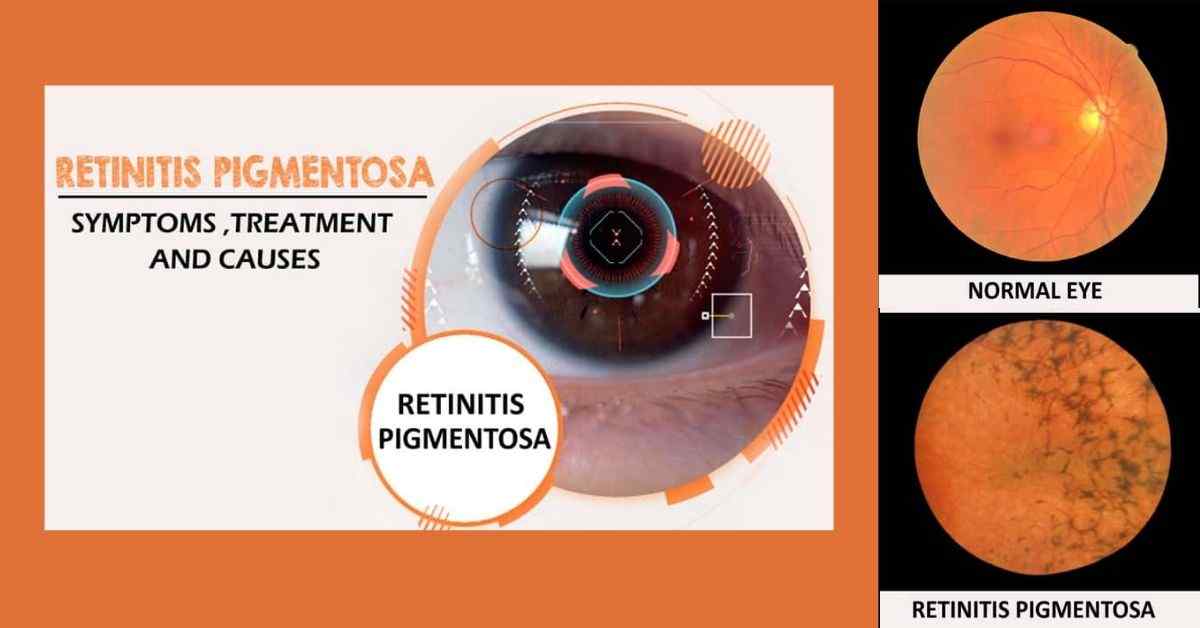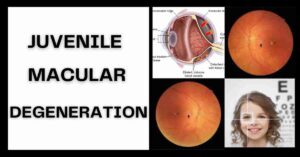Retinitis pigmentosa (RP) is a rare hereditary eye disease that causes progressive loss of vision over time. It develops due to the degeneration of the retina — the light-sensitive layer at the back of the eye.
Although considered uncommon, it is an important eye condition to recognise early because early diagnosis and visual protection can help slow down its progression.
According to the World Health Organization, more than 2.2 billion people worldwide live with a visual impairment, and inherited retinal diseases such as retinitis pigmentosa account for a significant proportion of avoidable vision loss.
Table of Contents
ToggleWhat is Retinitis Pigmentosa?
Retinitis pigmentosa is an umbrella term used to describe a group of inherited retinal disorders in which the retina slowly loses its ability to respond to light.
This occurs because of genetic mutations in one or more genes responsible for healthy retinal function.
Over time, the photoreceptor cells (rods and cones) die off, leading to progressive and irreversible vision loss.
Where Does Retinitis Pigmentosa Affect the Eye?
The main area affected is the retina, which:
- Detects light
- Converts it to electrical signals
- Sends the signals to the brain to form vision
In RP, degeneration starts most commonly in the rods (responsible for night and peripheral vision), then may progress to affect the cones (central and colour vision).
Symptoms of Retinitis Pigmentosa
The symptoms of RP usually develop gradually and may start in childhood or early adulthood. The rate of progression varies from person to person.
Here are the most common symptoms:
Symptom | Description / What the Patient Experiences |
Night blindness | Difficulty seeing in low-light conditions; first and most common symptom |
Peripheral vision loss | Side vision gradually becomes narrow (tunnel vision) |
Colour vision problems | Difficulty distinguishing colours, especially in later stages |
Flashes or twinkling lights | Sensation of light streaks or “shooting stars” |
Reduced central vision | Central vision slowly becomes blurred or distorted |
Complete vision loss (late stage) | Total blindness in severe or untreated cases |
Quick Tip
“If you often struggle to see in dim light or feel like you’re looking through a tunnel, don’t ignore it. These are early warning signs of retinitis pigmentosa — and early diagnosis can protect your remaining vision.”
Causes of Retinitis Pigmentosa
RP is caused by genetic mutations in the DNA. These mutations disrupt the function of cells in the retina and lead to progressive damage.
It is considered a hereditary eye disease, and there are three main inheritance patterns:
Type of Inheritance | How It Works | Risk for Children |
Autosomal Recessive RP | Both parents carry one defective gene | 25% chance of the child being affected |
Autosomal Dominant RP | One parent transfers a defective gene | 50% chance of the child being affected |
X-Linked RP | Mother carries defective gene on X-chromosome | Sons are affected; daughters are usually carriers |
It is also important to note that some patients develop RP without any known family history, due to new (spontaneous) mutations.
Diagnosis of Retinitis Pigmentosa
If RP is suspected, the ophthalmologist will perform a range of tests to confirm the diagnosis:
- Ophthalmoscopy – to look for abnormal pigmentation in the retina
- Visual field test – to determine peripheral vision loss
- Electroretinogram (ERG) – to measure how well retinal cells respond to light
- Genetic testing – to identify the specific gene mutation
Tip: If one family member has been diagnosed with RP, it is recommended that all first-degree relatives undergo screening as well.
Is Retinitis Pigmentosa the Same as Macular Degeneration?
Feature | Retinitis Pigmentosa | Macular Degeneration |
Cause | Genetic mutation | Age-related degeneration |
Photoreceptor affected | Mainly rods | Mainly cones |
Vision loss pattern | Night vision and peripheral vision first | Central vision first |
Age of onset | Early childhood to adulthood | Usually over 50 years |
Treatment Options for Retinitis Pigmentosa
Sadly, there is no cure for RP at present.
However, several treatment options are available to help slow progression or improve quality of life for patients.
Medical Management
Treatment | Purpose |
Vitamin A palmitate | May slow down retinal degeneration (taken under supervision) |
Acetazolamide | Reduces macular swelling in later stages |
Sunglasses | Protects the retina from UV light and slows progression |
Patients should avoid taking Vitamin E supplements alone, as studies show it can accelerate vision loss in RP.
Retinal Implant
In advanced cases, retinal implants such as Argus II may offer partial vision. These devices convert visual images into electrical impulses that stimulate the remaining retinal cells.
Emerging Therapies (Under Clinical Research)
- Gene therapy
- Stem cell therapy
- Retinal tissue transplantation
According to a 2023 report by the National Eye Institute, more than 40 clinical trials are currently evaluating gene and cell-based therapy for retinitis pigmentosa.
Personal Insight
“During my clinical training, I met patients who ignored night vision problems for years, believing it was ‘normal’. By the time they were diagnosed, the vision loss was already advanced.
Awareness and early screening are absolutely essential in hereditary eye diseases like RP.”
Frequently Asked Questions (People Also Ask)
Her are some common queries related to retinitis pigmentosa:
What is the first symptom of retinitis pigmentosa?
The earliest and most common symptom is night blindness, caused by degeneration of rod cells in the retina.
Can retinitis pigmentosa be treated?
There is no permanent cure, but treatments such as vitamin A palmitate, acetazolamide, sunglasses, and retinal implants may slow progression or improve remaining vision.
Is retinitis pigmentosa always genetic?
In most cases yes — RP is an inherited disease. However, some people develop RP with no family history due to new genetic mutations.
How fast does retinitis pigmentosa progress?
Progression varies, but most people develop significant vision loss by the age of 40–50. Some may retain useful vision up to age 80.
If you or someone in your family is experiencing night blindness, tunnel vision, or problems with colour vision, don’t wait.
- Schedule an eye examination with an ophthalmologist
- Explore more eye health topics on EyesOPT to stay informed and protect your vision

The latest research and updates straight to your inbox !
Join our subscribers for exclusive access to our monthly newsletter related to optometry





